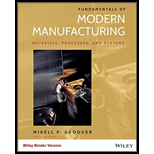
Concept explainers
(a)
It is preferred to balance the cycle times required to grind a particular workpiece using traditional surface grinding and by creep feed grinding. The workpiece is 200 mm long, 30 mm wide and 75 mm thick. To make a fair assessment, the grinding wheel in both cases is 250 mm in diameter and 35 mm in width, and rotates at 1500 rev/min. It is preferred to remove 25 mm of material from the surface. When traditional grinding is used, the in feed is set at 0.025 mm, and the wheel traverses twice across the work surface during each pass before resetting the in feed. There is no cross-feed as the wheel width is larger than the work width. Each pass should be made at a work speed of 12 m/min, but the wheel overshoots the part on both sides. With acceleration and deceleration, the wheel is engaged in the work for half of the time on each pass. When creep feed grinding is used, the depth is increased by 1000 and the forward feed is decreased by 1000. Evaluate the time to complete the operation with traditional; grinding.
(b)
It is preferred to balance the cycle times required to grind a particular workpiece using traditional surface grinding and by creep feed grinding. The workpiece is 200 mm long, 30 mm wide and 75 mm thick. To make a fair assessment, the grinding wheel in both cases is 250 mm in diameter and 35 mm in width, and rotates at 1500 rev/min. It is preferred to remove 25 mm of material from the surface. When traditional grinding is used, the in feed is set at 0.025 mm, and the wheel traverses twice across the work surface during each pass before resetting the in feed. There is no cross-feed as the wheel width is larger than the work width. Each pass should be made at a work speed of 12 m/min, but the wheel overshoots the part on both sides. With acceleration and deceleration, the wheel is engaged in the work for half of the time on each pass. When creep feed grinding is used, the depth is increased by 1000 and the forward feed is decreased by 1000. Evaluate the time to complete the operation with creep feed grinding.
Want to see the full answer?
Check out a sample textbook solution
Chapter 24 Solutions
Fundamentals of Modern Manufacturing, Binder Ready Version: Materials, Processes, and Systems
 Elements Of ElectromagneticsMechanical EngineeringISBN:9780190698614Author:Sadiku, Matthew N. O.Publisher:Oxford University Press
Elements Of ElectromagneticsMechanical EngineeringISBN:9780190698614Author:Sadiku, Matthew N. O.Publisher:Oxford University Press Mechanics of Materials (10th Edition)Mechanical EngineeringISBN:9780134319650Author:Russell C. HibbelerPublisher:PEARSON
Mechanics of Materials (10th Edition)Mechanical EngineeringISBN:9780134319650Author:Russell C. HibbelerPublisher:PEARSON Thermodynamics: An Engineering ApproachMechanical EngineeringISBN:9781259822674Author:Yunus A. Cengel Dr., Michael A. BolesPublisher:McGraw-Hill Education
Thermodynamics: An Engineering ApproachMechanical EngineeringISBN:9781259822674Author:Yunus A. Cengel Dr., Michael A. BolesPublisher:McGraw-Hill Education Control Systems EngineeringMechanical EngineeringISBN:9781118170519Author:Norman S. NisePublisher:WILEY
Control Systems EngineeringMechanical EngineeringISBN:9781118170519Author:Norman S. NisePublisher:WILEY Mechanics of Materials (MindTap Course List)Mechanical EngineeringISBN:9781337093347Author:Barry J. Goodno, James M. GerePublisher:Cengage Learning
Mechanics of Materials (MindTap Course List)Mechanical EngineeringISBN:9781337093347Author:Barry J. Goodno, James M. GerePublisher:Cengage Learning Engineering Mechanics: StaticsMechanical EngineeringISBN:9781118807330Author:James L. Meriam, L. G. Kraige, J. N. BoltonPublisher:WILEY
Engineering Mechanics: StaticsMechanical EngineeringISBN:9781118807330Author:James L. Meriam, L. G. Kraige, J. N. BoltonPublisher:WILEY





